USS Armadillo (IX-111), the lead ship of her class of tanker was the only ship of the United States Navy to be named for the armadillo, an insect-eating mammal which has an armorlike shell encasing its back and head.

USS Aldebaran (AF-10), the lead ship of her class of stores ship is the only ship of the United States Navy to have this name. She is named after Aldebaran, a star of the first magnitude in the constellation Taurus.
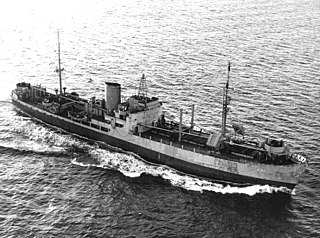
USS Pontiac (AF-20) was the Danish refrigerated cargo ship Australian Reefer that sought refuge in the neutral United States when Germany occupied Denmark in April 1940. In 1941 the United States seized 40 Danish ships idle in its ports with Australian Reefer being among those ships.

USS Pastores (AF-16) was a Pastores class store ship acquired by the U.S. Navy during World War I and re-acquired during World War II. Pastores served as a stores ship, responsible for delivering supplies to military personnel in combat and non-combat areas. She served in both World War I and II, and was awarded one battle star during World War II.

USS Mizar (AF-12) was the United Fruit Company fruit, mail and passenger liner Quirigua that served as a United States Navy Mizar-class stores ship in World War II.

USS Talamanca (AF-15) was the United Fruit Company cargo and passenger liner Talamanca that served as a United States Navy Mizar-class stores ship in World War II.

USS Tarazed (AF-13) was the United Fruit Company cargo and passenger liner Chiriqui that was acquired by the United States Navy through a sub bareboat charter from the War Shipping Administration (WSA) which acquired the ship by bareboat charter from the company. The ship served as a Mizar-class stores ship in World War II. In peacetime before and after the war she carried fruit and passengers; in war she supplied troops and ships in the field. In 1958 she was sold to a German shipping line and renamed Blexen which was scrapped in 1971 after 39 years' service.

USS Roamer (AF-19) was the Danish refrigerated motorship African Reefer, completed 1935, of the J. Lauritzen shipping company which had put in at Madeira after Germany occupied Denmark. The ship later sailed to a U.S. port on assurances it would be treated equally with U.S. vessels chartered for war purposes. Instead it was seized by the United States Maritime Commission and placed in service under War Shipping Administration (WSA) allotment to commercial, Army transport and finally Navy use at half the rate paid for U.S. ships. The agreed to rate was not restored until 1958 after a Supreme Court judgement and Congressional action.

USS Merak (AF-21), the second Navy ship of the name, was the United Fruit Company cargo and passenger liner Veragua that served as a United States Navy Mizar-class stores ship in World War II.

USS Karin (AF-33) was an Adria stores ship in service with the United States Navy from 1945 to 1958. She was into commercial service in 1969 and was scrapped in 1987.

USS Kerstin (AF-34) was an Adria class stores ship in service with the United States Navy from 1945 to 1950.
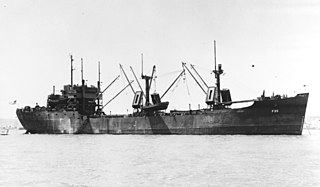
USS Latona (AF-35) was an Adria-class stores ship in service with the United States Navy from 1945 to 1949. She was scrapped in 1973.
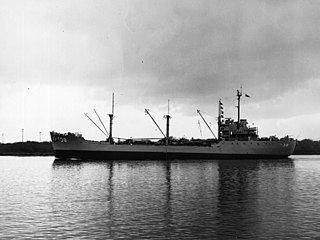
USS Merapi (AF-38) was an Adria stores ship acquired by the U.S. Navy for service in World War II, named after Mount Merapi, the mountain in Java, Indonesia. Her task was to carry stores, refrigerated items, and equipment to ships in the fleet, and to remote stations and staging areas.

USS Palisana (AF-39) was an Adria stores ship stores ship acquired by the U.S. Navy for service in World War II. Her task was to carry stores, refrigerated items, and equipment to ships in the fleet, and to remote stations and staging areas.

USS Gordonia (AF-43) was an Adria-class stores ship in service with the United States Navy from 1945 to 1946. She was scrapped in 1974.
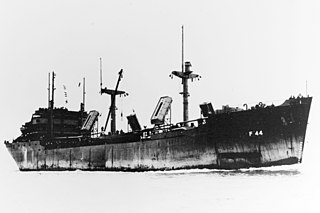
USS Laurentia (AF-44) was an Adria-class stores ship in service with the United States Navy from 1945 to 1946 and from 1950 to 1970. She was scrapped in 1973.
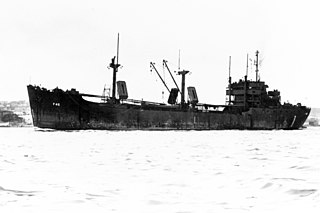
USS Lucidor (AF-45) was an Adria-class stores ship in service with the United States Navy from 1945 to 1946. She was sold into commercial service in 1967 and was lost in 1977.

USS George F. Elliott (AP-105) was a cargo liner built for the Mississippi Shipping Company as SS Delbrasil for operation between New Orleans and the east coast of South America in 1939 by its operator, Delta Line. The ship entered that service and operated until taken over by the War Shipping Administration (WSA) on 28 April 1942 for operation by Delta Line acting as WSA's agent. On 25 August 1943 WSA allocated the ship to the Navy for conversion to a troop transport commissioned and operated by the Navy for the duration of the war. Ownership of the ship was transferred from Mississippi Shipping to WSA on 4 February 1944 while under Navy operation and was retained until sale to American South African Lines on 22 December 1948. The ship was renamed African Endeavor until returned as a trade in to the Maritime Commission on 22 September 1960 for layup in the James River reserve fleet and later sold to Boston Metals for scrapping.
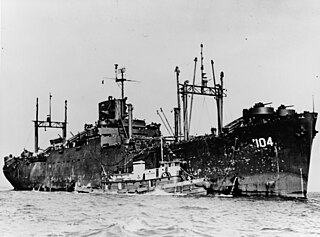
USS President Monroe (AP-104) was a President Jackson-class attack transport. that served with the US Navy during World War II. She was named after Founding Father and the fifth U.S. president, James Monroe.

The Type R ship is a United States Maritime Administration (MARAD) designation for World War II refrigerated cargo ship, also called a reefer ship. The R type ship was used in World War II, Korean War, Vietnam War and the Cold War. Type R ships were used to transport perishable commodities which require temperature-controlled transportation, such as fruit, meat, fish, vegetables, dairy products and other foods. The US Maritime Commission ordered 41 new refrigerated ships for the US Navy. Because of the difficulty of building refrigerated ships only two were delivered in 1944, and just 26 were delivered in 1945 and the remainder in 1946–48. The 41 R type ships were built in four groups. Two of design types were modified type C1 ships and two were modified type C2 ships. The United Fruit Company operated many of the R type ships in World War II. The type R2-S-BV1 became the US Navy Alstede-class stores ship and the type R1-M-AV3 became the US Navy Adria-class stores ship.



















